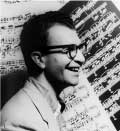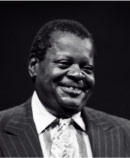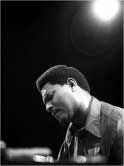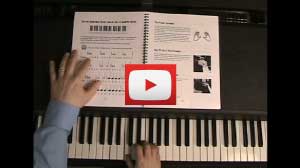Post Bop Pianists:
George Shearing, Dave Brubeck, Oscar Peterson, Bill Evans, McCoy Tyner, Herbie Hancock and Keith Jarrett
For the post bop pianists, anything was possible. A new, wider range of approaches to jazz piano were available. Pianists could bring all of previous influences of swing, bop, blues, gospel, and standards and with that, head into new directions. These pianists would expand the jazz piano vocabulary by using new techniques, rhythms, and free improvisation to widen the jazz pallette.
Here are some of the best post bop pianists.
George Shearing, 1919-2011
George Shearing was born in London, England and has been blind since birth. By the age of 3, he was easily picking out tunes on the piano, and memorizing them. By his twenties he was gigging regularly around London, specializing in boogie-woogie, and had met many American jazz greats that came through London. He became friends with Fats Waller, and accompanied many touring acts including Coleman Hawkins.
During the war, he was befriended by Glen Miller, who introduced Shearing to Leonard Feather. Feather was a British jazz impressario with many connections in the New York scene. Feather brought George to New York to record for the Savoy label, but he quickly returned to London to work with Stephane Grapelli, the swing violinist.
In 1947, Shearing returned to New York to stay, playing bop piano on 52nd St. By '49 he was developing his own style. This style featured the piano playing the melody in unison with vibraphone and guitar.
The George Shearing style is often called "locked hands," referring to the right hand playing block chords with the melody note on top, while the left hand doubles the melody an octave below. One of the most influential post bop pianists, Shearing made his name playing boogie, be bop, swing and then made his own sophisticated jazz piano sound. His most famous composition is "Lullaby of Birdland," which was a hit for him in 1952.
Dave Brubeck, 1920-2012

Dave Brubeck was born in California in 1920, and grew up as a farm boy, the son of a farmer and part-time rodeo rider. He loved being on the farm, never thinking that he would become a famous musician. Though he was taking classical piano lessons, he played local jazz gigs in high school. He went to the College of the Pacific, and later did post-graduate work with French composer Darius Milhaud, for whom he would later name one of his sons.
Brubeck served during WWII under General Patton, and would come back after the war, ready to make a career out of jazz.
Dave met alto saxophonist Paul Desmond in 1947, but they did not get along well initially. A few years later they began a long working relationship that produced the first million selling jazz song, "Take Five, " from an album called "Time Out." On this record and later recordings the Dave Brubeck Quartet would experiment with time signatures other than 4/4.
Dave Brubeck has a style that is easily recognized by his chordal approach and his cerebral, intellectual jazz. His goal is to make dissonance pleasing to the listener, and bring classical and jazz influeces together.
Oscar Peterson, 1925-2007

Oscar Peterson grew up in Montreal, Canada. His parents were from the British West Indies, and Oscar's father gave him his first piano lessons. Oscar was soon practicing 12 or more hours per day. Oscar played the classics, and particullarly enjoyed Rachmaninoff. He also studied Nat King Cole, James P. Johnson,Teddy Wilson and Art Tatum, his idol.
He became intrigued by boogie woogie, and easily mastered this form. At age 14, he won a prize after appearing on CBC radio, playing boogie piano. Oscar became a fixture on the Montreal jazz scene, and would meet the jazz greats as they came through town.
In 1949, producer Norman Granz heard Oscar on the radio, and was so impressed that he took him to New York to play at Carnegie Hall, opening the "Jazz At The Philharmonic" concert.
The accolades were just beginning. He won "Pianist of the Year" from Downbeat magazine in 1950. He would later win 7 Grammy Awards, the Glen Gould Prize ($50,000), the Companion of the Order of Canada, Officer of French Arts and Letters, Japan's Premium Imperial, and Chancellor of York University.
Through his 65 year career, Oscar Peterson proved to be one of the greatest pianists of all time, in jazz or any genre. He could play swing, bop, stride, blues and ballads. He had incredible chops, super-charged rhythm, plus power and speed unlike anyone else.
Bill Evans, 1929-1980
Bill Evans was born and raised in Plainfield, N.J. His music education began with violin lessons, but he later switched to piano and then flute. Bill studied the classics, and became an excellent sight reader. His favorite composers were Bach and Debussy. He went to Southern Louisiana University, and started making trips to New Orleans to hear the local jazz, and later would start playing some gigs.
In 1951, Evans was drafted and after his service stint ended in 1954,he headed to New York. Bill played some gigs, and was building his reputation. In '56 he played on a George Russell album, which drew attention to his playing. Riverside Records signed Evans, and he releasedNew Jazz Conceptions, which only sold 800 copies in its first year, but his unique talent was evident.
Miles Davis asked Bill to join his quintet in 1958, and he performed on most of Kind of Blue, the biggest selling jazz album of all time. Bill's modal approach to the harmony would define the "new" Miles sound. Miles Davis would later describe Evans as his favorite pianist. While in the Davis group he began a long battle with heroin addiction that shadowed the rest of his life.
After leaving Davis, Bill started his first trio with Paul Motion on drums and Scott LaFaro on bass. This trio played like they were all on the same wavelength, though they would never rehearse. Lafaro was killed in a motorcycle accident, which deeply affected Evans. He later re-started the trio with Chuck Isreals on bass.
Of the post bop pianists, Bill Evans may be the most influential with his restrained but emotionally charged playing. He voiced chords in a way to bring out the most emotion with his light but fluid touch. He rarely played fast tunes or blues, but there was a "blueness" to his sound. Though he had a serious level of technique, he never let it get in the way.
McCoy Tyner 1938-

McCoy Tyner, from Philadelphia, P.A., started playing piano at age 13 with his mother's direction. As a teenager, he was friends with Bobby Timmons, Lee Morgan and Archie Shepp; all who would also become jazz legends. He started his first group at 15, playing R&B. McCoy soon discovered his true passion was in jazz. He studied the classics plus Monk and Bud Powell, who would later move nearby. McCoy was lucky enough to have some private lessons with Bud.
At 17, McCoy met John Coltrane, who was temporarily living in Philly. He helped Coltrane work through tunes, including the 'Trane classic "Giant Steps." Later, Benny Golson took Tyner out on the road, and would ask him to play on the recording of his most famous number, "Killer Joe."
In 1960, Coltrane put together a quartet, and McCoy was asked to be the pianist. This band would shake the foundation of jazz with their powerful free improvisations. It was called a band "with a non-rhythm section." McCoy's playing style developed to match huge sheets of sound made by this group. McCoy employed crashing chords composed of stacks of fourths and fifths; forte bass octaves and lots of sustain pedal. McCoy left the band when he became uncomfortable with the total freedom of form. He was looking for his own sound, and began his career as a leader.
In the many years since, Tyner has expolred jazz with orchestration, voices, a big band, trios, small bands and solo performances.
McCoy Tyner has possibly the most distinctive style of the post bop pianists. His huge chords, tremolos, octaves and his elastic sense of time make McCoy Tyner unmistakeable.
Herbie Hancock, 1940-
Herbie Hancock was born and raised in Chicago, and began piano lessons at age 7. By the time he was 11, Herbie was proficient enough to perform Mozart's Piano Concerto #5 with the Chicago Symphony. He was deeply into classical piano, but by his teens he had discovered Oscar Peterson and George Shearing. He later found inspiration in the playing of Bill Evans, McCoy Tyner, Wynton Kelly and Ravel.
Herbie headed to college as a physics major, but soon switched to music. In 1961 he left college and worked with Donald Byrd and Coleman Hawkins, who brought him to New York. He made his Blue Note Records debut in '62 with the album Takin' Off, which featured "Watermelon Man." Mongo Santamaria recorded it, had a major hit, and now it is a jazz standard.
Shortly after, Miles Davis asked Hancock to join his new quintet, which would become one of the major forces shaping jazz in the '60's. This group also included drummer Tony Williams, bassist Ron Carter, and tenor saxophonist Wayne Shorter. During this period, Herbie found his unique voice, creating harmony in fourths and playing in a style described as "time - no changes."
While with Miles, and after, Herbie continued to record for Blue Note as a leader and as a sideman on dozens of albums.
Towards the end of his time with Miles, he asked Herbie to try playing the Fender Rhodes electric piano. From this point, Herbie experimented with many electric keyboards, synthesizers and effects. His band, The Headhunters, released a groundbreaking jazz/funk record that greatly influenced the sound of the '70's. He had a huge hit on MTV in the early '80's with his synth-pop/funk tune "Rockit."
Herbie always returns to acoustic jazz. He released a few records withg his former Miles bandmates as "VSOP." Herbie Hancock has been a hugely influential post bop pianist, always creating something new. He recently won the "Album of the Year" Grammy in 2007 for The Joni Letters, his tribute to Joni Mitchell. He is the first jazz artist to win in that category.
Keith Jarrett, 1945-
Keith Jarrett, from Allentown, P.A., was a gifted musician from an early age. He played his first paid concert at age 6, and performed two of his own compositions as part of the program. After high school, Keith went to Berklee College of Music in Boston, and also played cocktail piano gigs around town.
Jarrett moved to New York after his time at Berklee, and got a gig at the Village Vanguard. Art Blakey heard him there, and asked Keith to join the Jazz Messengers. The Blakey gig led to more gigs, with Rahsaan Roland Kirk, Charles Lloyd and then with Miles Davis. During this period with other artists, he was also making records as a leader. He started working with a trio including Paul Motion on drums and Charlie Haden on bass in 1969.
He stayed with Miles through the early '70's, playing electric piano and can be heard on a number of live recordings from that period. He later grew to dislike the electric piano, and electrified music in general.
Through the '70's and '80's he led an Amercan and a European quartet, each with a distinctive sound. He also performed solo piano concerts, for which he may be best known. During this time he also performed and recorded numerous classical works by Bach, Mozart and others. In the early '80's he started his "standards" trio with Jack DeJohnette on drums and Gary Peacock on bass, recording many albums in this format.
In the late '90's, Jarrett suffered from Chronic Fatigue Syndrome, and was forced to "retire" for a while. He returned to touring in 2000, and continues to perform today. Of the post bop pianists, Keith Jarrett may be the most eclectic, easily playing free jazz, standards, classical, and intense solo improvisations.
Photos:
Dave Brubeck: Public Domain
Oscar Peterson: Tom Marcello - Creative Commons Lic.
McCoy Tyner: Gisele Hannemyr - Creative Commons Lic.
Creative Commons
Start Playing Piano Today with the Piano Guide Quick Start Course!
Easy to follow step-by-step lessons designed for adult beginners. The next best thing to private lessons!
What You'll Learn:
- Notes on the piano/keyboard
- Proper fingering
- C major scale
- Chords
- How to read music
- And much more!

Video lessons - watch as I play everything for you.

